B203B TMA: Analysis of Tesco's Recruitment and Selection Processes
VerifiedAdded on 2023/04/23
|5
|1397
|174
Report
AI Summary
This report provides a comprehensive analysis of Tesco's recruitment and selection processes. It begins by examining the methods Tesco employs to attract and recruit candidates, including both internal talent plans and external recruitment strategies through its website and job boards. The report explores the advantages and disadvantages of each approach, such as the potential for fresh perspectives versus the risk of reduced employee morale. The report then delves into the benefits of assessment centers and interviews in Tesco's selection process, highlighting the consistency and accuracy these methods provide. It details how assessment centers, incorporating exercises like problem-solving and team-building, help assess candidates' capabilities, and how interviews gather crucial information about candidates' skills, experience, and behavior. The report concludes by emphasizing how the use of these techniques enables Tesco to identify and select the most suitable candidates, aligning them with specific job requirements and contributing to the company's overall efficiency. The report is based on the assignment brief provided by the Arab Open University for the B203B module, focusing on the context of business functions.
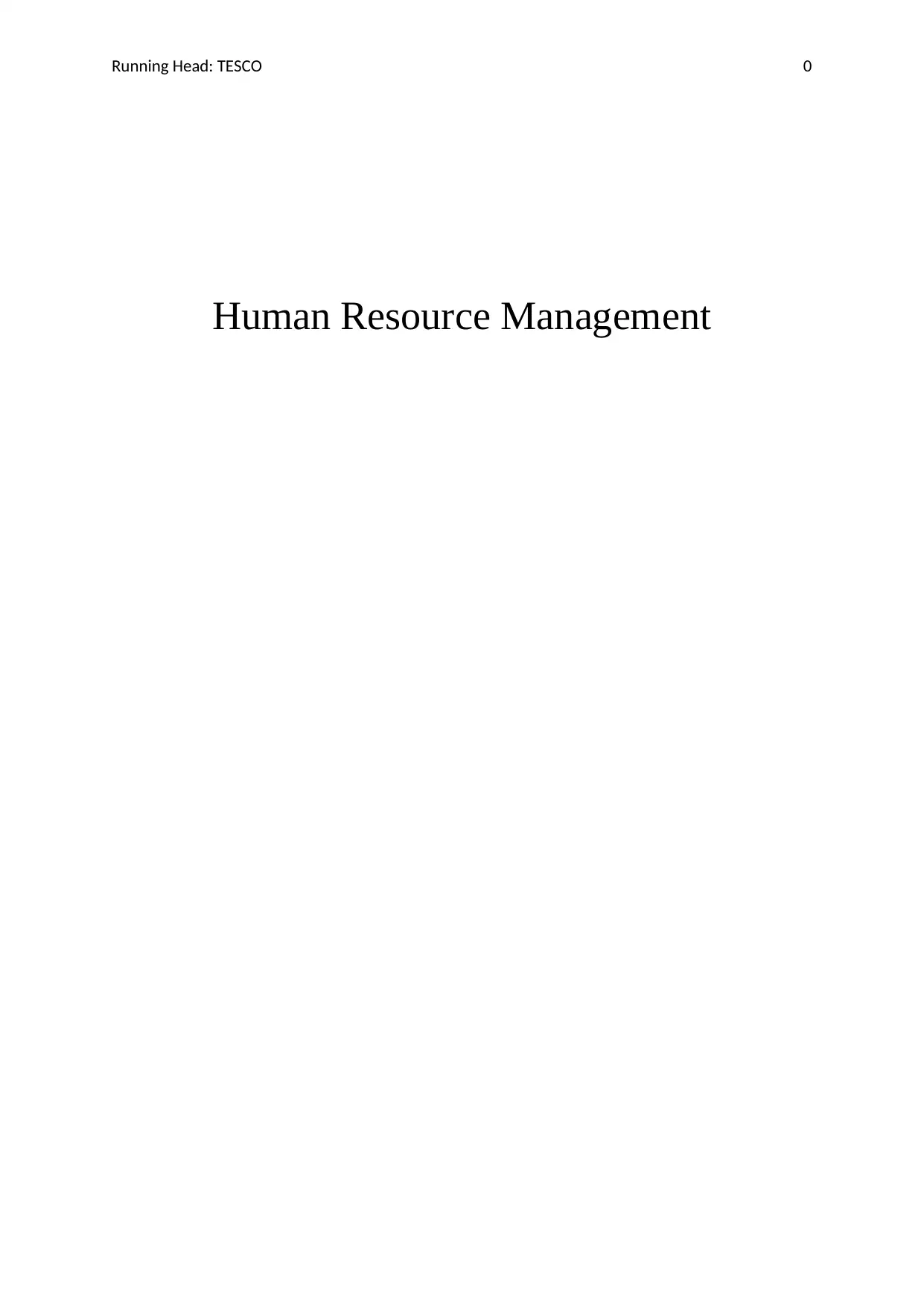
Running Head: TESCO 0
Human Resource Management
Human Resource Management
Paraphrase This Document
Need a fresh take? Get an instant paraphrase of this document with our AI Paraphraser
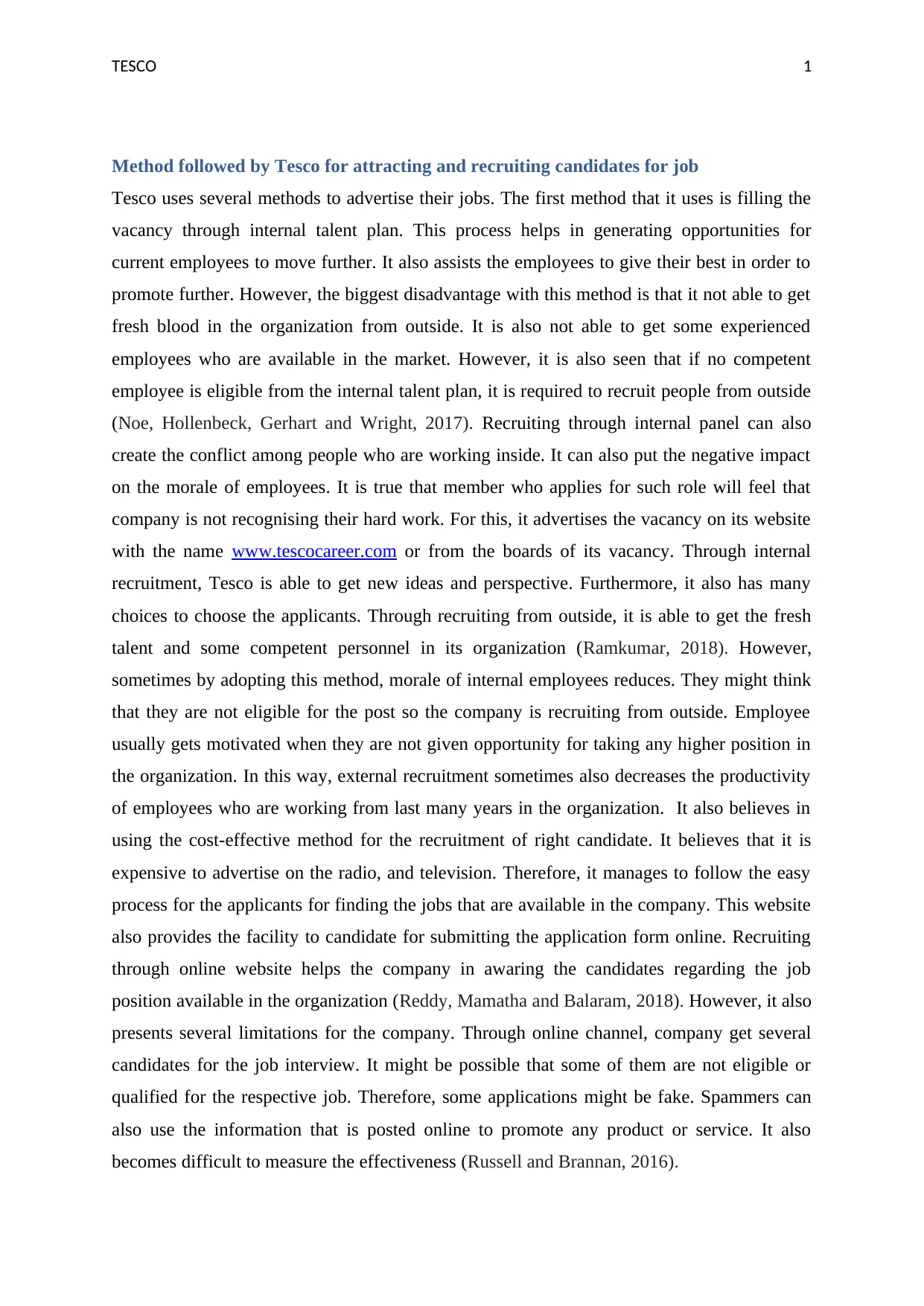
TESCO 1
Method followed by Tesco for attracting and recruiting candidates for job
Tesco uses several methods to advertise their jobs. The first method that it uses is filling the
vacancy through internal talent plan. This process helps in generating opportunities for
current employees to move further. It also assists the employees to give their best in order to
promote further. However, the biggest disadvantage with this method is that it not able to get
fresh blood in the organization from outside. It is also not able to get some experienced
employees who are available in the market. However, it is also seen that if no competent
employee is eligible from the internal talent plan, it is required to recruit people from outside
(Noe, Hollenbeck, Gerhart and Wright, 2017). Recruiting through internal panel can also
create the conflict among people who are working inside. It can also put the negative impact
on the morale of employees. It is true that member who applies for such role will feel that
company is not recognising their hard work. For this, it advertises the vacancy on its website
with the name www.tescocareer.com or from the boards of its vacancy. Through internal
recruitment, Tesco is able to get new ideas and perspective. Furthermore, it also has many
choices to choose the applicants. Through recruiting from outside, it is able to get the fresh
talent and some competent personnel in its organization (Ramkumar, 2018). However,
sometimes by adopting this method, morale of internal employees reduces. They might think
that they are not eligible for the post so the company is recruiting from outside. Employee
usually gets motivated when they are not given opportunity for taking any higher position in
the organization. In this way, external recruitment sometimes also decreases the productivity
of employees who are working from last many years in the organization. It also believes in
using the cost-effective method for the recruitment of right candidate. It believes that it is
expensive to advertise on the radio, and television. Therefore, it manages to follow the easy
process for the applicants for finding the jobs that are available in the company. This website
also provides the facility to candidate for submitting the application form online. Recruiting
through online website helps the company in awaring the candidates regarding the job
position available in the organization (Reddy, Mamatha and Balaram, 2018). However, it also
presents several limitations for the company. Through online channel, company get several
candidates for the job interview. It might be possible that some of them are not eligible or
qualified for the respective job. Therefore, some applications might be fake. Spammers can
also use the information that is posted online to promote any product or service. It also
becomes difficult to measure the effectiveness (Russell and Brannan, 2016).
Method followed by Tesco for attracting and recruiting candidates for job
Tesco uses several methods to advertise their jobs. The first method that it uses is filling the
vacancy through internal talent plan. This process helps in generating opportunities for
current employees to move further. It also assists the employees to give their best in order to
promote further. However, the biggest disadvantage with this method is that it not able to get
fresh blood in the organization from outside. It is also not able to get some experienced
employees who are available in the market. However, it is also seen that if no competent
employee is eligible from the internal talent plan, it is required to recruit people from outside
(Noe, Hollenbeck, Gerhart and Wright, 2017). Recruiting through internal panel can also
create the conflict among people who are working inside. It can also put the negative impact
on the morale of employees. It is true that member who applies for such role will feel that
company is not recognising their hard work. For this, it advertises the vacancy on its website
with the name www.tescocareer.com or from the boards of its vacancy. Through internal
recruitment, Tesco is able to get new ideas and perspective. Furthermore, it also has many
choices to choose the applicants. Through recruiting from outside, it is able to get the fresh
talent and some competent personnel in its organization (Ramkumar, 2018). However,
sometimes by adopting this method, morale of internal employees reduces. They might think
that they are not eligible for the post so the company is recruiting from outside. Employee
usually gets motivated when they are not given opportunity for taking any higher position in
the organization. In this way, external recruitment sometimes also decreases the productivity
of employees who are working from last many years in the organization. It also believes in
using the cost-effective method for the recruitment of right candidate. It believes that it is
expensive to advertise on the radio, and television. Therefore, it manages to follow the easy
process for the applicants for finding the jobs that are available in the company. This website
also provides the facility to candidate for submitting the application form online. Recruiting
through online website helps the company in awaring the candidates regarding the job
position available in the organization (Reddy, Mamatha and Balaram, 2018). However, it also
presents several limitations for the company. Through online channel, company get several
candidates for the job interview. It might be possible that some of them are not eligible or
qualified for the respective job. Therefore, some applications might be fake. Spammers can
also use the information that is posted online to promote any product or service. It also
becomes difficult to measure the effectiveness (Russell and Brannan, 2016).
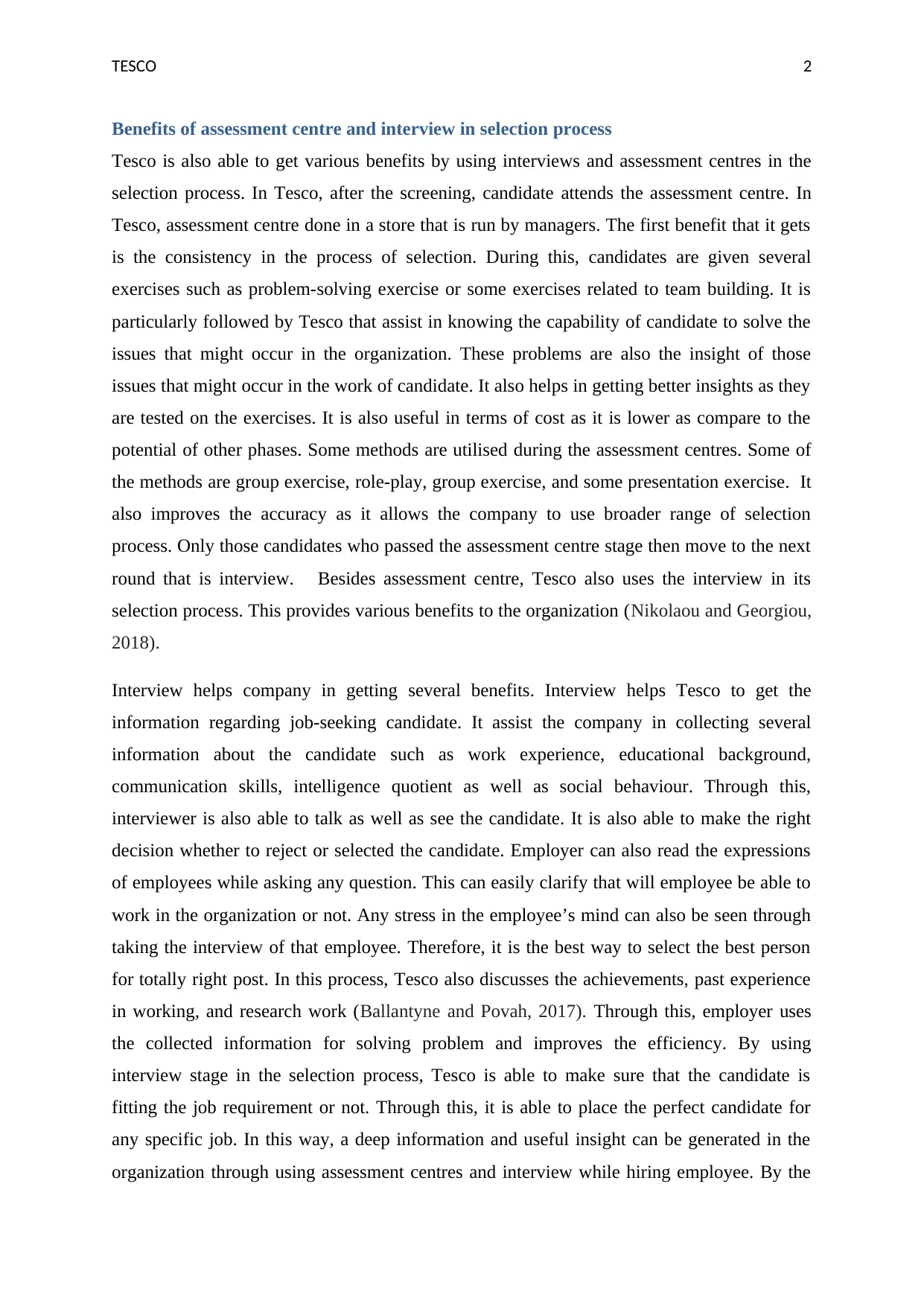
TESCO 2
Benefits of assessment centre and interview in selection process
Tesco is also able to get various benefits by using interviews and assessment centres in the
selection process. In Tesco, after the screening, candidate attends the assessment centre. In
Tesco, assessment centre done in a store that is run by managers. The first benefit that it gets
is the consistency in the process of selection. During this, candidates are given several
exercises such as problem-solving exercise or some exercises related to team building. It is
particularly followed by Tesco that assist in knowing the capability of candidate to solve the
issues that might occur in the organization. These problems are also the insight of those
issues that might occur in the work of candidate. It also helps in getting better insights as they
are tested on the exercises. It is also useful in terms of cost as it is lower as compare to the
potential of other phases. Some methods are utilised during the assessment centres. Some of
the methods are group exercise, role-play, group exercise, and some presentation exercise. It
also improves the accuracy as it allows the company to use broader range of selection
process. Only those candidates who passed the assessment centre stage then move to the next
round that is interview. Besides assessment centre, Tesco also uses the interview in its
selection process. This provides various benefits to the organization (Nikolaou and Georgiou,
2018).
Interview helps company in getting several benefits. Interview helps Tesco to get the
information regarding job-seeking candidate. It assist the company in collecting several
information about the candidate such as work experience, educational background,
communication skills, intelligence quotient as well as social behaviour. Through this,
interviewer is also able to talk as well as see the candidate. It is also able to make the right
decision whether to reject or selected the candidate. Employer can also read the expressions
of employees while asking any question. This can easily clarify that will employee be able to
work in the organization or not. Any stress in the employee’s mind can also be seen through
taking the interview of that employee. Therefore, it is the best way to select the best person
for totally right post. In this process, Tesco also discusses the achievements, past experience
in working, and research work (Ballantyne and Povah, 2017). Through this, employer uses
the collected information for solving problem and improves the efficiency. By using
interview stage in the selection process, Tesco is able to make sure that the candidate is
fitting the job requirement or not. Through this, it is able to place the perfect candidate for
any specific job. In this way, a deep information and useful insight can be generated in the
organization through using assessment centres and interview while hiring employee. By the
Benefits of assessment centre and interview in selection process
Tesco is also able to get various benefits by using interviews and assessment centres in the
selection process. In Tesco, after the screening, candidate attends the assessment centre. In
Tesco, assessment centre done in a store that is run by managers. The first benefit that it gets
is the consistency in the process of selection. During this, candidates are given several
exercises such as problem-solving exercise or some exercises related to team building. It is
particularly followed by Tesco that assist in knowing the capability of candidate to solve the
issues that might occur in the organization. These problems are also the insight of those
issues that might occur in the work of candidate. It also helps in getting better insights as they
are tested on the exercises. It is also useful in terms of cost as it is lower as compare to the
potential of other phases. Some methods are utilised during the assessment centres. Some of
the methods are group exercise, role-play, group exercise, and some presentation exercise. It
also improves the accuracy as it allows the company to use broader range of selection
process. Only those candidates who passed the assessment centre stage then move to the next
round that is interview. Besides assessment centre, Tesco also uses the interview in its
selection process. This provides various benefits to the organization (Nikolaou and Georgiou,
2018).
Interview helps company in getting several benefits. Interview helps Tesco to get the
information regarding job-seeking candidate. It assist the company in collecting several
information about the candidate such as work experience, educational background,
communication skills, intelligence quotient as well as social behaviour. Through this,
interviewer is also able to talk as well as see the candidate. It is also able to make the right
decision whether to reject or selected the candidate. Employer can also read the expressions
of employees while asking any question. This can easily clarify that will employee be able to
work in the organization or not. Any stress in the employee’s mind can also be seen through
taking the interview of that employee. Therefore, it is the best way to select the best person
for totally right post. In this process, Tesco also discusses the achievements, past experience
in working, and research work (Ballantyne and Povah, 2017). Through this, employer uses
the collected information for solving problem and improves the efficiency. By using
interview stage in the selection process, Tesco is able to make sure that the candidate is
fitting the job requirement or not. Through this, it is able to place the perfect candidate for
any specific job. In this way, a deep information and useful insight can be generated in the
organization through using assessment centres and interview while hiring employee. By the
⊘ This is a preview!⊘
Do you want full access?
Subscribe today to unlock all pages.

Trusted by 1+ million students worldwide
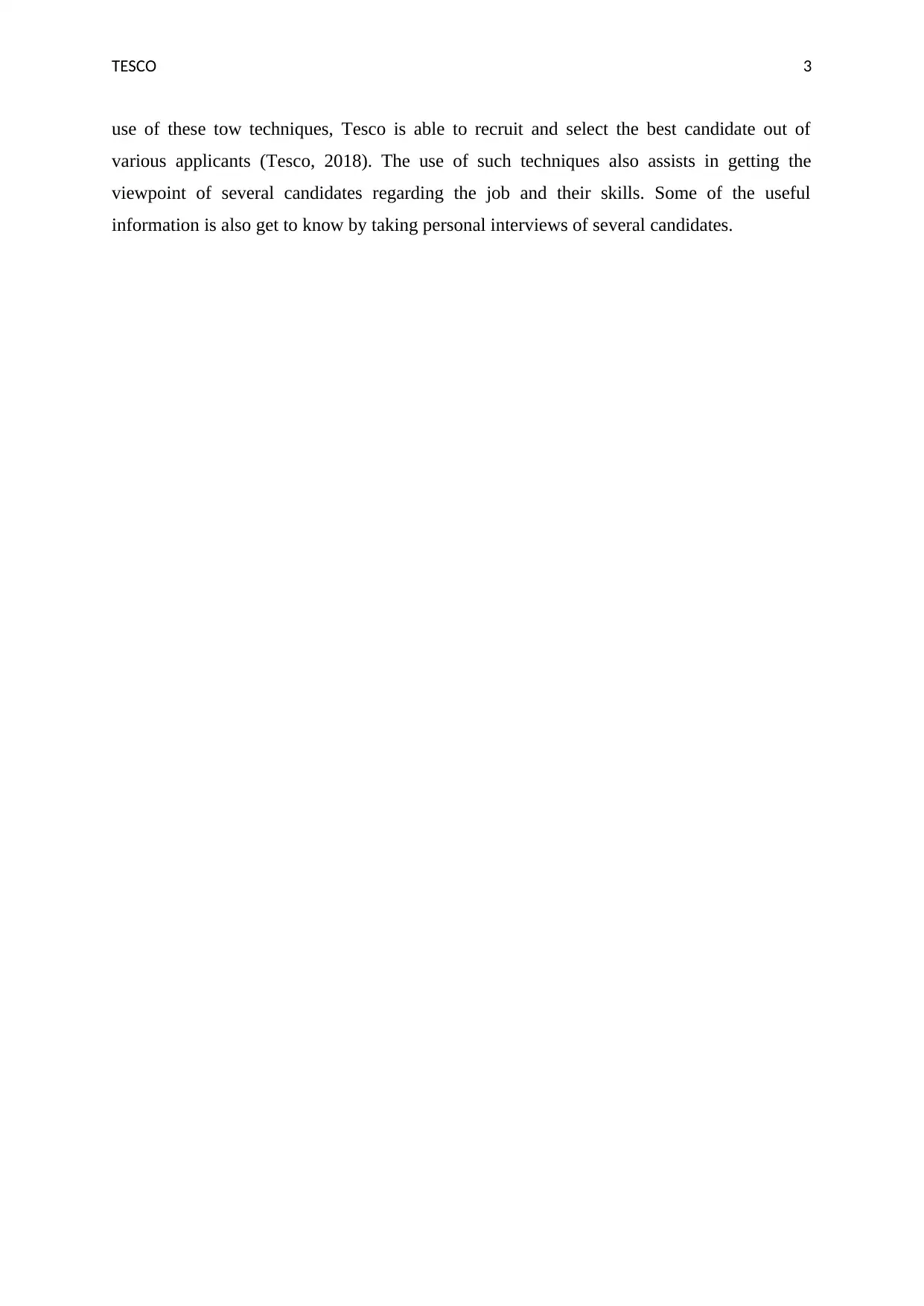
TESCO 3
use of these tow techniques, Tesco is able to recruit and select the best candidate out of
various applicants (Tesco, 2018). The use of such techniques also assists in getting the
viewpoint of several candidates regarding the job and their skills. Some of the useful
information is also get to know by taking personal interviews of several candidates.
use of these tow techniques, Tesco is able to recruit and select the best candidate out of
various applicants (Tesco, 2018). The use of such techniques also assists in getting the
viewpoint of several candidates regarding the job and their skills. Some of the useful
information is also get to know by taking personal interviews of several candidates.
Paraphrase This Document
Need a fresh take? Get an instant paraphrase of this document with our AI Paraphraser
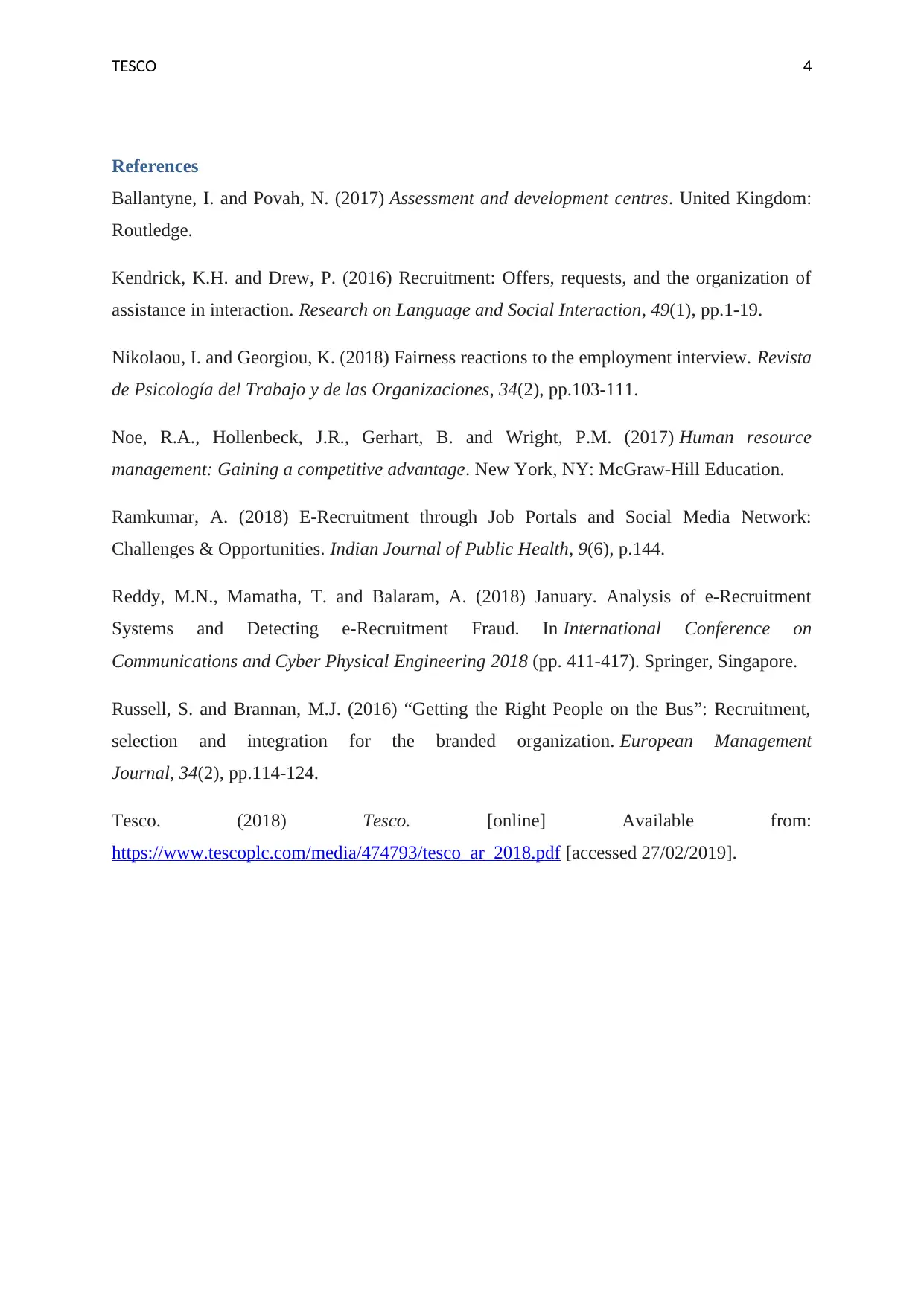
TESCO 4
References
Ballantyne, I. and Povah, N. (2017) Assessment and development centres. United Kingdom:
Routledge.
Kendrick, K.H. and Drew, P. (2016) Recruitment: Offers, requests, and the organization of
assistance in interaction. Research on Language and Social Interaction, 49(1), pp.1-19.
Nikolaou, I. and Georgiou, K. (2018) Fairness reactions to the employment interview. Revista
de Psicología del Trabajo y de las Organizaciones, 34(2), pp.103-111.
Noe, R.A., Hollenbeck, J.R., Gerhart, B. and Wright, P.M. (2017) Human resource
management: Gaining a competitive advantage. New York, NY: McGraw-Hill Education.
Ramkumar, A. (2018) E-Recruitment through Job Portals and Social Media Network:
Challenges & Opportunities. Indian Journal of Public Health, 9(6), p.144.
Reddy, M.N., Mamatha, T. and Balaram, A. (2018) January. Analysis of e-Recruitment
Systems and Detecting e-Recruitment Fraud. In International Conference on
Communications and Cyber Physical Engineering 2018 (pp. 411-417). Springer, Singapore.
Russell, S. and Brannan, M.J. (2016) “Getting the Right People on the Bus”: Recruitment,
selection and integration for the branded organization. European Management
Journal, 34(2), pp.114-124.
Tesco. (2018) Tesco. [online] Available from:
https://www.tescoplc.com/media/474793/tesco_ar_2018.pdf [accessed 27/02/2019].
References
Ballantyne, I. and Povah, N. (2017) Assessment and development centres. United Kingdom:
Routledge.
Kendrick, K.H. and Drew, P. (2016) Recruitment: Offers, requests, and the organization of
assistance in interaction. Research on Language and Social Interaction, 49(1), pp.1-19.
Nikolaou, I. and Georgiou, K. (2018) Fairness reactions to the employment interview. Revista
de Psicología del Trabajo y de las Organizaciones, 34(2), pp.103-111.
Noe, R.A., Hollenbeck, J.R., Gerhart, B. and Wright, P.M. (2017) Human resource
management: Gaining a competitive advantage. New York, NY: McGraw-Hill Education.
Ramkumar, A. (2018) E-Recruitment through Job Portals and Social Media Network:
Challenges & Opportunities. Indian Journal of Public Health, 9(6), p.144.
Reddy, M.N., Mamatha, T. and Balaram, A. (2018) January. Analysis of e-Recruitment
Systems and Detecting e-Recruitment Fraud. In International Conference on
Communications and Cyber Physical Engineering 2018 (pp. 411-417). Springer, Singapore.
Russell, S. and Brannan, M.J. (2016) “Getting the Right People on the Bus”: Recruitment,
selection and integration for the branded organization. European Management
Journal, 34(2), pp.114-124.
Tesco. (2018) Tesco. [online] Available from:
https://www.tescoplc.com/media/474793/tesco_ar_2018.pdf [accessed 27/02/2019].
1 out of 5
Related Documents
Your All-in-One AI-Powered Toolkit for Academic Success.
+13062052269
info@desklib.com
Available 24*7 on WhatsApp / Email
![[object Object]](/_next/static/media/star-bottom.7253800d.svg)
Unlock your academic potential
Copyright © 2020–2025 A2Z Services. All Rights Reserved. Developed and managed by ZUCOL.





